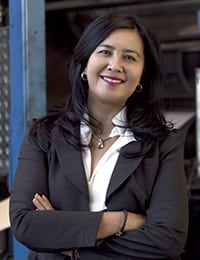
Sharon J. Prill is Group Publisher & President of the Seattle Times Affiliate News Group and the Yakima Herald-Republic. NAA caught up with Prill to discuss her roll, leading the transformation of a newspaper and her take on the future of news media.
What drew you to working in news media?
In hindsight I think I was always destined to work in media but didn’t necessarily know it. My initial ambition was to become an artist and if that didn’t work out, an economics analyst! In college, a friend and I started a monthly newspaper with the mission of connecting transient university students to the surrounding neighborhood communities just “for fun.” We did this for a year before graduating and ironically in all that time I never considered working for a real media company. It was just a hobby that coincidentally turned out to be my future career and obsession.
What is the most exciting thing going on at the Yakima Herald-Republic?
There are lots of exciting things going at the YH-R, but what I am most excited about is all the experimentation we are doing to grow audience and revenue. In our print editions, we’ve added new reader features, blown out local election coverage – rivaling what you might find in bigger media markets – and created opportunities for reader interaction through a special project devoted to “Stories from our Families” – a multi-part multimedia series on generations that make up the Valley.
Online, we’ve launched several successful regional classifieds verticals, one that includes an SMS advertiser text application, redesigned for mobile experience, and deployed social media initiatives that have contributed to growing our traffic page views by 42 percent this year. Next year, we are looking to engage the team in “design-thinking” processes pioneered by the Institute of Design at Stanford and introduce a variation of Agile product development methods in the workplace.
What has surprised you the most while working as the newspaper’s first female and minority publisher and president?
How much that means to others, in particular our Filipino-American community. I never set out to be a “first” and honestly didn’t want that to be the focus for my appointment as I’ve worked so hard to be taken seriously for my work. However, it was really gratifying walking around the Herald-Republic packaging center those first weeks on the job and meeting people from around the community who were so genuine in their good wishes, and expressed pride for my accomplishment.
Speaking in our native Tagalog, we talked about the Philippines, foods I missed while living in the Midwest, aspirations they had for their own families, and the occasional boast of how many jobs one was able to juggle to get to the States.
Through those conversations, I came to realize that my role went well beyond the normal changing of the guard. Here I was part of that family aspiration, something I hadn’t thought about before. It was extremely humbling, and instilled in me a heightened sense of responsibility to “represent” and be more open about my ethnic roots.
What is the most important thing you’ve learned about modernizing a newspaper to become a multimedia business?
The threats to our media businesses are the biggest they have ever been, but so are the opportunities. To thrive in this kind of an environment, you’ve got to be willing to take more calculated risks and be ready to respond to market and audience trends. That means being resilient to change and ready to pivot against the excellent plan you just completed.
We do a lot of pivoting around here and often take a “MacGyver-like” approach to problems. We don’t always get it right, but we are working hard as a leadership team to promote an agile and resourceful culture unafraid to experiment, but conversely respectful of metrics to inform action and direction. Technology alone is not going to save us – it’s what we do with it.
How do you see the future of news media?
In one word: mobile. Everything you do should take mobile experience into consideration. And no, just because you are in a small market doesn’t mean you get to wait this one out. Mobile usage across the country is growing at an exponential rate influencing offline behaviors as much as online. If you want to get some really good insights into the digital future, read Mary Meeker’s annual report on Internet trends. It will scare you and excite you at the same time.
